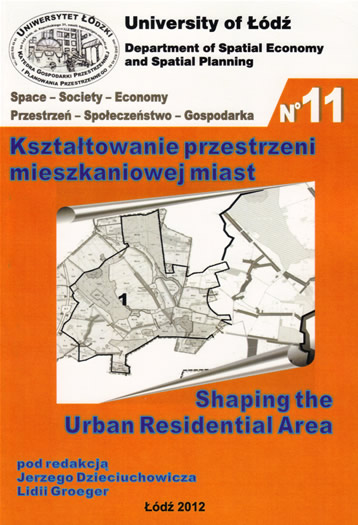THE VALUE OF RESIDENTIAL SPACE AS AFFECTED BY LANDSCAPE PERCEPTION – THE EXAMPLE OF THE CITY OF OLSZTYN
DOI:
https://doi.org/10.18778/1733-3180.11.07Abstract
The concept of landscape is associated primarily with visual perception, but landscape amenities can be also perceived by other senses, including the hearing, smell and touch (multisensory perception). According to available data, the visual landscape and the aural landscape complement each other (visual sensations are accompanied by aural stimuli). In urbanized areas, property value is affected by both the visual and aural perception of scenery attributes. The prices of real estates located within one residential complex or several neighboring complexes may vary widely. The results of our previous study show that one of the reasons for differences in real estate prices is the quality of green spaces which play a key role in landscape perception. The above is observed particularly in the living environment, including housing areas, where people spend long periods of time. The objective of this study was to validate our previous findings and to determine the effect of street noise intensity on the prices of residential premises (multi-family housing) on the local real estate market. The studied dataset was homogeneous in terms of the location and type of property, but it differed with respect to landscape values (access to green areas, noise level). The visual and aural perception of landscape by potential homebuyers affected their assessment of residential space. The analysis covered a multi-family housing estate located in the city of Olsztyn. The results were interpreted in view of purchase-and-sale transactions of residential premises concluded in 2009–2010 (involving cooperative ownership titles), landscape evaluation by a quantitative classification method, and the acoustic map developed for the city.
Downloads
References
Bajerowski T. (red.), Biłozor A., Cieślak I., Senetra A., Szczepańska A., 2007, Ocena i wycena krajobrazu. Wybrane problemy rynkowej oceny i wyceny krajobrazu wiejskiego, miejskiego i stref przejściowych, Educaterra, Olsztyn.
Google Scholar
Kosmala M., 2005, Po co ludziom drzewa, czyli o roli znaczeniu drzew w życiu człowieka [w:] Zieleń Miejska. Naturalne bogactwo miasta. Zasady gospodarowania i ochrona, Materiały konferencyjne, Wyd. PZITS, Toruń.
Google Scholar
Kowalczyk A., 1992, Badania spostrzegania krajobrazu multisensorycznego – podstawą kształtowania obszarów rekreacyjnych, Wydawnictwo WSP, Bydgoszcz.
Google Scholar
Nowy słownik języka polskiego PWN, 2003, Wydawnictwo Naukowe PWN, Warszawa.
Google Scholar
Osikowska W., Przetacznik J., 2007, Problemy percepcji i oceny estetycznej krajobrazu Krakowa, „Roczniki Geomatyki”, t. 5, z. 8.
Google Scholar
Rudawa D., 2006, Projektowanie nie „zazielenianie”, „Facility Manager”, No 2(19).
Google Scholar
Senetra A., Cieślak I., 2004, Kartograficzne aspekty oceny i waloryzacji przestrzeni, Wydawnictwo Uniwersytetu Warmińsko-Mazurskiego, Olsztyn.
Google Scholar
Senetra A., Rostek J., 2010, Możliwości wykorzystania GIS w procesie szacowania nieruchomości. Mapa wartości krajobrazowych, Wycena 4/2009.
Google Scholar
Suchocka M., 2007, Ile zarabiają drzewa w mieście, Materiały seminaryjne i poseminaryjne konferencji pt. Drzewa w mieście, Polski Klub Ekologiczny, Okrąg Górnośląski, Koło Miejskie w Tychach, Tychy.
Google Scholar
Szczepanowska H. B., 2007, Wycena drzew na terenach miejskich, Materiały seminaryjne i poseminaryjne konferencji pt. Drzewa w mieście, Polski Klub Ekologiczny, Okrąg Górnośląski, Koło Miejskie w Tychach, Tychy.
Google Scholar
http://213.184.21.79/geoportal/dotnetviewerolsztyn/ajaxviewerolsztyn.aspx – stan z 2010-09-15.
Google Scholar
Downloads
Published
How to Cite
Issue
Section
License

This work is licensed under a Creative Commons Attribution-NonCommercial-NoDerivatives 3.0 Unported License.









